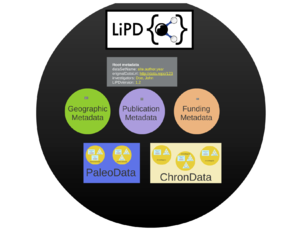Difference between revisions of "Linked Paleo Data"
Nick mckay (Talk | contribs) (→LiPD in LinkedEarth) |
Nick mckay (Talk | contribs) (→LiPD components) |
||
| Line 18: | Line 18: | ||
[[File:Lipd_structure.png|300px|thumb|left|structure of a lipd file]] | [[File:Lipd_structure.png|300px|thumb|left|structure of a lipd file]] | ||
| − | + | There are 6 possible components to a LiPD dataset: | |
=== Root Metadata === | === Root Metadata === | ||
| + | This describes metadata that applies to the whole dataset. Common examples are: | ||
| + | |||
| + | *Dataset Name | ||
| + | *Investigators | ||
| + | *Link to online dataset | ||
| + | *LiPD version | ||
=== Geographic Metadata === | === Geographic Metadata === | ||
| + | Here the the site location is described following the geoJSON standard. This includes: | ||
| + | |||
| + | *Coordinates | ||
| + | *Sitename | ||
| + | *Descriptive location (e.g.,) | ||
| + | **Country | ||
| + | **State | ||
| + | **Province | ||
| + | **Ocean | ||
| + | |||
| + | |||
=== Publication Metadata === | === Publication Metadata === | ||
| Line 28: | Line 45: | ||
=== PaleoData Table === | === PaleoData Table === | ||
=== ChronData Table === | === ChronData Table === | ||
| − | |||
| − | |||
== LiPD implementation == | == LiPD implementation == | ||
Revision as of 18:47, 3 March 2017
Contents
LiPD: Linked Paleo Data
The LiPD vision
Paleoclimate investigators have made a major effort over the past decade to make their data available to the broader community, largely through online archiving systems like the World Data Center for Paleoclimatology and Pangaea. However, there is no agreed-upon data standard for how to store and exchange such data. As the number of records in these archives has grown, making connections manually has thus become more and more challenging, hampering integrative efforts at the very time they should be flourishing. Paleoclimatologists thus need a common tongue to describe their datasets to each other and to machines.
LiPD (Linked Paleo Data) proposes such a common tongue. It is a universally-readable data container that organizes data and metadata in a uniform way, such that they may be web-searchable, and such that a variety of code functionalities may be built and apply instantly to any dataset that observes that standard.
For more details, see this article.
LiPD in LinkedEarth
LiPD is a convenient way to store and exchange paleoclimate format, and is an important building block of the LinkedEarth edifice. However, it is important to note that the LinkedEarth database grown via the wiki is not reliant on LiPD. LiPD is merely a convenient way to exchange paleoclimate data, and is convenient way to import data to the wiki, or extract a dataset from the wiki for analysis. LiPD is closely aligned with the LinkedEarth ontology, changes in one are often reflected in the other (with a small lag).
Structuring data : the LiPD Way
LiPD components
There are 6 possible components to a LiPD dataset:
Root Metadata
This describes metadata that applies to the whole dataset. Common examples are:
- Dataset Name
- Investigators
- Link to online dataset
- LiPD version
Geographic Metadata
Here the the site location is described following the geoJSON standard. This includes:
- Coordinates
- Sitename
- Descriptive location (e.g.,)
- Country
- State
- Province
- Ocean
Publication Metadata
Funding Metadata
PaleoData Table
ChronData Table
LiPD implementation
LiPD is centered on JSON-LD, a JSON-based format compliant with the Linked Data paradigm. JavaScript Object Notation (JSON) is an extremely lightweight and flexible way to encode information, and has become the leading format for data exchange on the Web. Linked Data are datasets that observe common rules to be able to be automatically linked through the World Wide Web. A LiPD file (.lpd) is in fact a zipped folder containing:
LIST CONTENTS OF A LIPD FILE (csv files, JSON-LD file, md5 tag, etc)
